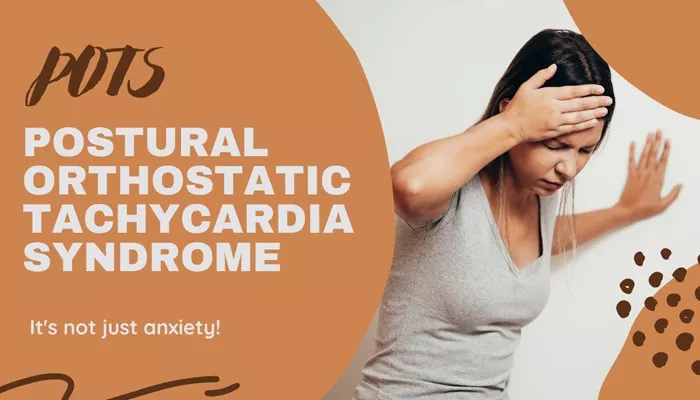Postural Tachycardia Syndrome (POTS) is a complex disorder of the autonomic nervous system characterized primarily by an excessive increase in heart rate upon standing. It falls under the broader category of orthostatic intolerance disorders, where symptoms arise due to inadequate blood flow to the heart and brain when moving from lying or sitting to a standing position. This condition can lead to significant functional impairment, affecting daily activities and quality of life. Although POTS is often underdiagnosed, awareness has increased due to its distinctive clinical features and the growing recognition of its impact on patients.
What Causes POTS?
The exact cause of POTS remains unclear, but it is understood to involve multiple mechanisms related to autonomic nervous system dysfunction. Key contributing factors include:
Autonomic Nervous System Malfunction: The autonomic nervous system, which controls involuntary bodily functions such as heart rate and blood vessel constriction, fails to regulate blood flow properly when standing, leading to blood pooling in the lower body and insufficient return to the heart.
Hypovolemia: Many POTS patients have a reduced blood volume, which worsens the symptoms by limiting the amount of blood available to circulate when upright.
Hyperadrenergic State: Some patients exhibit elevated levels of norepinephrine (a stress hormone) when standing, causing excessive sympathetic nervous system activation and increased heart rate.
Genetic and Familial Links: POTS is more common in females, often beginning in adolescence, and may run in families. It can also be associated with connective tissue disorders like Ehlers-Danlos syndrome and conditions such as fibromyalgia, chronic fatigue syndrome, and irritable bowel syndrome.
Triggers: POTS symptoms may first appear or worsen after viral infections, physical trauma, surgery, or prolonged bed rest.
Environmental factors such as heat, dehydration, and prolonged standing can exacerbate symptoms.
Symptoms of POTS
Symptoms of POTS are diverse and can affect multiple organ systems. They typically worsen upon standing and improve when lying down. Common symptoms include:
Cardiovascular: Rapid heart rate increase (tachycardia) exceeding 30 beats per minute (40 bpm in adolescents) within 10 minutes of standing, palpitations, chest pain, and sometimes lightheadedness or fainting.
Neurological: Dizziness, brain fog (difficulty concentrating, memory problems), headaches, blurred or tunnel vision, and weakness in the legs.
Gastrointestinal: Nausea, vomiting, bloating, diarrhea, constipation, and abdominal pain.
Respiratory: Shortness of breath and difficulty breathing.
Other: Fatigue, sleep disturbances including insomnia, excessive sweating, shakiness or tremors, and changes in skin color such as pallor or purple discoloration of hands and feet when lowered below heart level.
Symptoms often fluctuate daily and can be aggravated by heat, stress, exercise, or after meals. The severity ranges from mild to disabling, with some patients experiencing chronic symptoms that significantly impair their quality of life.
Diagnosis of POTS
Diagnosis is primarily clinical and involves:
Heart Rate Monitoring: A sustained increase in heart rate of at least 30 bpm (or 40 bpm in those under 19) within 10 minutes of standing without a significant drop in blood pressure confirms POTS.
Tilt Table Test: This test measures cardiovascular responses to changes in posture and helps differentiate POTS from other causes of orthostatic intolerance.
Exclusion of Other Conditions: It is important to rule out other causes of tachycardia and orthostatic symptoms, such as dehydration, anemia, or thyroid disorders.
Treatment of POTS
Treatment of POTS is multifaceted and tailored to individual patient needs, focusing on symptom relief and improving functional capacity.
Non-Pharmacological Treatments
Lifestyle Modifications: Increasing fluid and salt intake helps expand blood volume. Avoiding triggers such as prolonged standing, heat exposure, and large meals can reduce symptom severity.
Compression Garments: Wearing compression stockings or abdominal binders helps reduce blood pooling in the legs and improves venous return.
Physical Therapy: Graded exercise programs, such as the Levine Protocol, start with recumbent exercises progressing to upright activities to improve autonomic function and cardiovascular conditioning.
Postural Adjustments: Techniques like crossing legs while standing or sitting in low chairs can help manage symptoms during daily activities.
Pharmacological Treatments
Medications are used when lifestyle changes are insufficient:
| Medication | Mechanism & Use | Notes |
| β-blockers | Reduce heart rate and sympathetic activation; improve quality of life | Propranolol and bisoprolol commonly used; may help with tachycardia and anxiety |
| Ivabradine | Selectively lowers heart rate by inhibiting sinoatrial node “funny current” | Particularly effective in hyperadrenergic POTS; improves heart rate and symptoms |
| Fludrocortisone | Increases blood volume by promoting sodium retention | Used to treat hypovolemia |
| Midodrine | Vasoconstrictor that improves blood pressure and reduces pooling | Helps with orthostatic intolerance |
| Pyridostigmine | Enhances autonomic nervous system function by inhibiting acetylcholinesterase | Beneficial in autoimmune-related POTS |
| Droxidopa | Precursor to norepinephrine; may improve standing tolerance and fatigue | Under investigation; promising early results |
Other medications such as calcium channel blockers (e.g., verapamil) may be used cautiously, especially in hyperadrenergic forms, but can worsen venous pooling.
Advanced And Emerging Therapies
Autonomic Reconditioning Therapy: Structured physical therapy aimed at retraining autonomic responses using gradual upright exercises.
Electrical Stimulation (TENS): May improve blood flow and autonomic regulation; more research is needed but some patients report symptom relief.
Multidisciplinary Care: Programs involving cardiology, neurology, rehabilitation, and psychology provide comprehensive management tailored to patient needs.
Conclusion
This overview highlights the complexity of POTS as a disorder of autonomic regulation, emphasizing the importance of individualized diagnosis and treatment strategies. Ongoing research continues to improve understanding and expand therapeutic options for this challenging syndrome.
Related topics:


